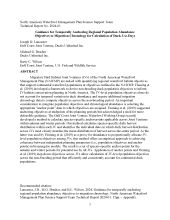
ABSTRACT
Migratory Bird Habitat Joint Ventures (JVs) of the North American Waterfowl Management Plan (NAWMP) are tasked with quantifying regional waterfowl habitat objectives that support continental waterfowl populations at objectives outlined in the NAWMP. Fleming et al. (2019) developed a framework to derive non-breeding duck population objectives to inform JV habitat conservation planning in North America. The JV-level population objectives alone do not account for temporal variation in duck abundance and require additional migration chronology data to compute objectives across the non-breeding period. An important consideration to integrate population objectives and chronological abundance is selecting the appropriate “anchor point” date to which objectives are assigned. Fleming et al. (2019) suggested anchoring objectives at midpoints of the planning periods but acknowledged a need for more defensible guidance. The Gulf Coast Joint Venture Waterfowl Working Group recently developed a method to calculate species-specific anchor points applicable across Joint Ventures within autumn and winter periods. Our method calculates species-specific daily harvest distribution within each JV and identifies the individual date on which daily harvest distribution across JVs most closely matches the mean distribution of harvest across the entire period. As the latter was used by Fleming et al. (2019) as a proxy for abundance to proportionally allocate JV-level population objectives among JVs, this method offers an empirical approach to achieving coherence between independent planning parameters (i.e., population objectives and anchor points) in bioenergetic models. The result is a set of species-specific anchor points for the autumn and winter periods for potential use by all JVs. Application of anchor points and Fleming et al. (2019) step-down objectives across JVs allow calculation of JV-level population objectives across the non-breeding period that efficiently and consistently account for continental duck populations.
